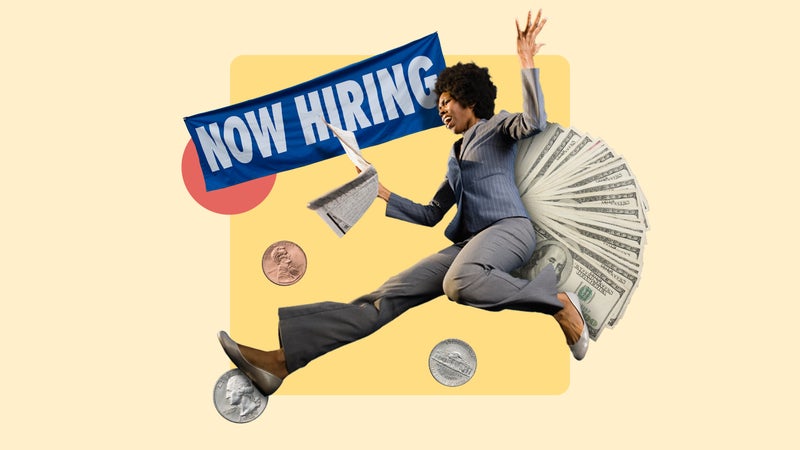Survey: Inflation is slowing fast but still might not hit the Fed’s target until 2025

The Bankrate promise
At Bankrate we strive to help you make smarter financial decisions. While we adhere to strict , this post may contain references to products from our partners. Here's an explanation for .
The surprisingly resilient U.S. job market isn’t the only corner of the economy defying the odds. So too is the slowdown in inflation pressures.
When 2022 came to a close, Federal Reserve officials warned consumers and investors that prices might not slow as quickly as they did over the previous 12 months. The rate of inflation had dropped by almost 3 percentage points in the year — a historically quick rate of disinflation — and they predicted that the next mile might be the hardest part of the journey.
It ended up being far from the case. The rate of inflation in 2023 slowed even more than it did in 2022, dipping more than 3 percentage points over the 12-month period, according to the Bureau of Labor Statistics’s consumer price index (CPI). Even the Fed’s preferred gauge of inflation — the personal consumption expenditures (PCE) index — showed a sharper slowdown.
Economists, however, remain on guard about a potential headfake. Most of the nation’s top economists (60 percent) indicated in Bankrate’s poll that they don’t expect inflation to officially hit the Fed’s 2 percent target until the end of 2025. That’s an even larger share than the near 2-in-5 (or 41 percent) who expected slowing inflation to take that long in the prior-quarter poll. About 1 in 5 economists (or 20 percent) see inflation sinking to 2 percent by the end of 2024, while another 20 percent see elevated inflation lingering until the end of 2026 or later. Both are down from 29 percent in the third quarter.
Elevated inflation has more implications for consumers than just continued trouble affording the items they both want and need. The Fed will also be inclined to keep pushing down on the brakes to slow the economy until price pressures seem subdued.
While investors and central bankers appear increasingly confident that a recession has been avoided, economists tell us they believe the risks are still elevated as we assess the outlook for the coming year.— Mark Hamrick | Bankrate senior economic analyst
Key insights on the economy from Bankrate’s fourth-quarter Economic Indicator poll
Inflation is slowing, but economists are wary about that progress continuing
Tracking inflation is getting trickier than it used to be. Economists closely watch annual inflation rates, but those gauges are currently reflecting major increases from the decades-high inflation rates of 2022. They might be masking some of the progress.
Instead, economists say month-over-month or six-month annualized rates might be the best way to gauge how inflation is behaving in real time. And if the past six months of inflation trends were to continue for a full year, prices would only rise 1.9 percent when excluding the more volatile food and energy categories, a Bankrate analysis of the Department of Commerce’s PCE index shows.
That’s the slowest rate since 2020 and technically below the Fed’s target. It also reflects two years of significant improvement. Inflation trends between September 2022 and February 2023 would lead to a 4.7 percent annual inflation rate.
“Disinflation is the word of the month,” says Mike Fratantoni, chief economist at the Mortgage Bankers Association. “Annualizing the rate of change over the past three- or six-month time periods shows that inflation is likely headed significantly lower in the medium term.”
Key measures to watch are shelter costs and services.
In the Bureau of Labor Statistics’s measure, shelter costs looked like they peaked in March 2023. Price increases in the crucial category have slowed every month since then, with the current 6.5 percent annual inflation rate the slowest since September 2022.
Yet, economists note that those measures of housing prices are backward-looking, lagging what’s happening in the current market by a year if not more. More recent housing indicators have pointed to resurging home prices. A key index tracking home prices rose for the eighth straight month and topped a new record in September, according to S&P CoreLogic’s latest Case-Shiller Home Price Index.
Services inflation, meanwhile, is up 5.5 percent from a year ago, stickier than inflation impacting goods, according to the Bureau of Labor Statistics.
“Improvement in inflation is ongoing and the keys to further slowing are shelter and core services,” says Dante DeAntonio, senior director at Moody’s Analytics. “On both fronts, we expect additional moderation over the next year.”
An even bigger wild card could be what happens with gasoline, food and energy prices. Those commodities are closely tied to supply chains. Economists listed global conflicts in the Middle East and Ukraine as predominant risks that could interrupt disinflation. They’re also issues the Fed can’t do much to fix. Monetary policy cannot produce more oil or boost exports; it can only dissuade demand.
“My greatest area of concern remains the impact of potential geopolitical tensions on key aspects of the U.S. manufacturing supply chains,” says Nayantara Hensel, chief economist at Seaborne Defense. “That could lead to shortages of key inputs and higher prices, thus contributing to higher inflation and slower economic growth.”
Here’s what the nation’s top economists are saying about inflation
“Contrary to popular belief, there’s no reason to assume that the final mile of disinflation will be the most challenging. Five key elements have already materialized and will form the perfect mix for disinflation going into 2024: diminished consumer demand growth, declining housing rent inflation, narrower profit margins, moderating wage growth and tight monetary policy.”
— Gregory DacoChief Economist at EY
“Though the term ‘transitory’ was discredited through the inflation of 2021-22, the steep climb in the price level did mostly reflect distortions from supply chain disruptions, and many — though not all — high-profile price gains will continue to be reversed through 2024.”
— Mike EnglundChief Economist at Action Economics
“Inflation will continue its downward trend and reach the 3 percent threshold in the early part of 2024. A sustained level of below 3 percent inflation will be enough to signal to the Federal Reserve that inflation is coming down to their target.”
— Yelena MaleyevSenior Economist at KPMG
-
The Fourth-Quarter 2023 Bankrate Economic Indicator Survey of economists was conducted Dec. 11-18. Survey requests were emailed to economists nationwide, and responses were submitted voluntarily online. Responding were: Mike Fratantoni, chief economist, Mortgage Bankers Association; Odeta Kushi, deputy chief economist, First American Financial Corporation; Nayantara Hensel, Ph.D., chief economist, Seaborne Defense; Yelena Maleyev, senior economist, KPMG US; John E. Silvia, founder, Dynamic Economic Strategy; Gregory Daco, chief economist, EY; Scott Anderson, chief U.S. economist, BMO; Dante DeAntonio, senior director, Moody’s Analytics; Lawrence Yun, chief economist, National Association of Realtors; Bernard Markstein, president and chief economist, Markstein Advisors; Robert Frick, corporate economist, Navy Federal Credit Union; Bill Dunkelberg, chief economist, NFIB; Joseph Mayans, director of U.S. economics, Experian; Sean Snaith, director, Institute for Economic Forecasting, College of Business at the University of Central Florida; and Mike Englund, chief economist, Action Economics.

